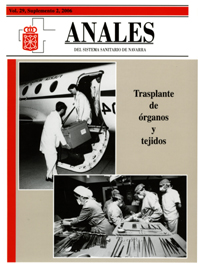Monitoring and secondary effects of immunosuppressants in the transplant
Keywords:
Inmunosupresores. Rango terapéutico. Interacciones medicamentosas.Abstract
The success of organ transplants and their consideration as a clearly established treatment in some indications is due to the development of immunosuppressant drugs. While it was not the first of the drugs to be employed, the introduction of cyclosporin in the 1980s in immunosuppressant treatment made possible an increase in the number of transplants and the success of this practice. From then onwards, immunosuppression has been based on the use of a combination of drugs, initially cyclosporin, corticoids and azathioprine. In recent years new drugs have been introduced that have opened up the possibilities of treatment. But many pending questions remain, due to the toxicity associated with their use and the possibility of interaction with other drugs, which complicates their use and can compromise the prognoses of these patients. Calcineurin inhibitors and mTOR are the drugs involved with greater frequency in interactions with other drugs, which makes it necessary to anticipate this possibility when the concomitant medication is changed.Downloads
Downloads
Published
How to Cite
Issue
Section
License
La revista Anales del Sistema Sanitario de Navarra es publicada por el Departamento de Salud del Gobierno de Navarra (España), quien conserva los derechos patrimoniales (copyright ) sobre el artículo publicado y favorece y permite la difusión del mismo bajo licencia Creative Commons Reconocimiento-CompartirIgual 4.0 Internacional (CC BY-SA 4.0). Esta licencia permite copiar, usar, difundir, transmitir y exponer públicamente el artículo, siempre que siempre que se cite la autoría y la publicación inicial en Anales del Sistema Sanitario de Navarra, y se distinga la existencia de esta licencia de uso.








